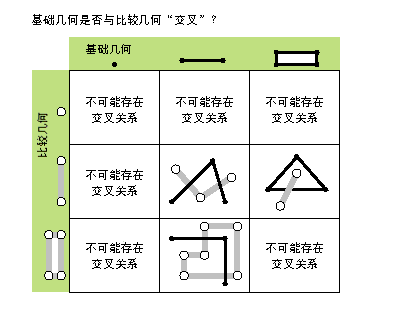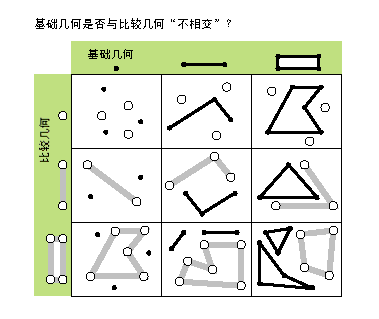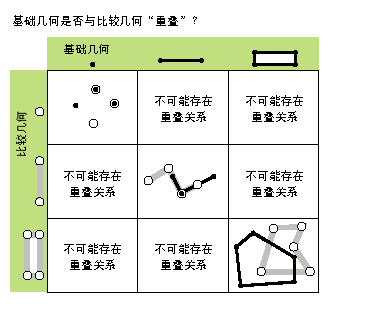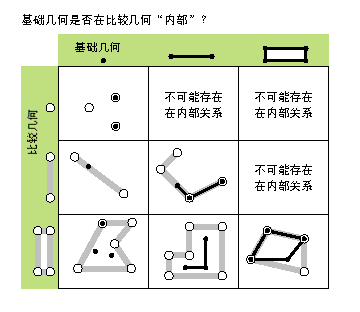摘要
点对象经常与光标配合使用。点要素将返回单个点对象而不是点对象数组。而其他要素类型(面、折线和多点)都将返回一个点对象数组,并且当这些要素具有多个部分时,则返回包含多个点对象数组的数组。
讨论
点并非几何类,但通常用于构造几何。在以下示例中,点用于创建 PointGeometry 对象。
point = arcpy.Point(25282, 43770)
ptGeometry = arcpy.PointGeometry(point)
语法
Point ({X}, {Y}, {Z}, {M}, {ID})| 参数 | 说明 | 数据类型 |
X | 点的 X 坐标。 (默认值为 0.0) | Double |
Y | 点的 Y 坐标。 (默认值为 0.0) | Double |
Z | 点的 Z 坐标。 (默认值为 None) | Double |
M | 点的 M 值。 (默认值为 None) | Double |
ID | 点的形状 ID。 (默认值为 0) | Integer |
属性
| 属性 | 说明 | 数据类型 |
| ID (读写) | An integer used to uniquely identify the point. | Integer |
| M (读写) | The measure value of the point. | Double |
| X (读写) | The horizontal coordinate of the point. | Double |
| Y (读写) | The vertical coordinate of the point. | Double |
| Z (读写) | The elevation value of the point. | Double |
方法概述
| 方法 | 说明 |
| clone (point_object) | 克隆点对象。 |
| contains (second_geometry) | 指明基础几何中是否包含比较几何。 包含与在内部相反。 本图仅显示 True 关系。  |
| crosses (second_geometry) | 指明两个几何是否相交于较小形状类型的几何。 如果两条折线仅共用公共点(至少有一个点不是端点),则这两条折线交叉。如果折线和面在面(不等于整条折线)的内部共享一条折线或一个公共点(对于垂线),那么该折线与面交叉。 本图仅显示 True 关系。  |
| disjoint (second_geometry) | 指明基础几何和比较几何是否未共用任何点。 如果 disjoint 返回 False,则两个几何相交。 本图仅显示 True 关系。  |
| equals (second_geometry) | 指示原几何和参照几何的 shape 类型是否相同并在平面中定义相同点集。这仅是 2D 的比较;已忽略 M 值和 Z 值。 本图仅显示 True 关系。  |
| overlaps (second_geometry) | 指示两个几何的交集是否具有与其中一个输入几何相同的形状类型,并且不等于任一输入几何。 本图仅显示 True 关系。  |
| touches (second_geometry) | 指示几何的边界是否相交。 当两个几何的交集不为空,但它们内部的交集为空时,说明两个几何接触。例如,仅当点与折线的一个终点重合时,才表示点与折线接触。 本图仅显示 True 关系。  |
| within (second_geometry) | 指明基础几何是否位于比较几何之内。 被包含是与包含相反的运算符。 本图仅显示 True 关系。  |
方法
clone (point_object)
| 参数 | 说明 | 数据类型 |
point_object | 点对象。 | Point |
contains (second_geometry)
| 参数 | 说明 | 数据类型 |
second_geometry | A second geometry. | Object |
返回值
| 数据类型 | 说明 |
| Boolean | 返回布尔值 True 表示该几何包含第二个几何。 |
crosses (second_geometry)
| 参数 | 说明 | 数据类型 |
second_geometry | A second geometry. | Object |
返回值
| 数据类型 | 说明 |
| Boolean | 返回布尔值为 True 指明两个几何相交于较小形状类型的几何。 |
disjoint (second_geometry)
| 参数 | 说明 | 数据类型 |
second_geometry | A second geometry. | Object |
返回值
| 数据类型 | 说明 |
| Boolean | 返回布尔值 True 表示两个几何未共用任何点。 |
equals (second_geometry)
| 参数 | 说明 | 数据类型 |
second_geometry | A second geometry. | Object |
返回值
| 数据类型 | 说明 |
| Boolean |
返回布尔值为 True 表示两个几何的 shape 类型相同并在平面中定义了相同点集。 |
overlaps (second_geometry)
| 参数 | 说明 | 数据类型 |
second_geometry | A second geometry. | Object |
返回值
| 数据类型 | 说明 |
| Boolean | 返回布尔值为 True 表示两个几何的交集具有与其中一个输入几何相同的尺寸。 |
touches (second_geometry)
| 参数 | 说明 | 数据类型 |
second_geometry | A second geometry. | Object |
返回值
| 数据类型 | 说明 |
| Boolean | 返回布尔值为 True,表示几何的边界相交。 |
within (second_geometry)
| 参数 | 说明 | 数据类型 |
second_geometry | A second geometry. | Object |
返回值
| 数据类型 | 说明 |
| Boolean | 返回布尔值 True 表示该几何被包含在另一个几何之内。 |
代码实例
点示例
创建点对象并显示其属性。
import arcpy
# Create point object
point = arcpy.Point(2000, 2500)
# Print point properties
print("Point properties:")
print(" ID: {0}".format(point.ID))
print(" X: {0}".format(point.X))
print(" Y: {0}".format(point.Y))
点示例 2
检查面数组对象中的点对象,这些点对象由几何对象所返回。
import arcpy
# Create cursor to retrieve Hawaii shape
feature_class = "c:/data/Hawaii.shp"
cursor = arcpy.da.SearchCursor(feature_class, ["SHAPE@"])
for row in cursor:
# Get the geometry object from the shape field
print("Number of Hawaiian islands: {0}".format(row[0].partCount))
# GetPart returns an array of point objects for each part.
for island in row[0].getPart():
print("Vertices in island: {0}".format(island.count))
for point in island:
print("X: {0}, Y: {1})".format(point.X, point.Y))